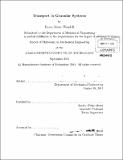| dc.contributor.advisor | Anette (Peko) Hosoi. | en_US |
| dc.contributor.author | Wendell, Dawn M. (Dawn Marie), 1983- | en_US |
| dc.contributor.other | Massachusetts Institute of Technology. Dept. of Mechanical Engineering. | en_US |
| dc.date.accessioned | 2012-02-29T18:21:50Z | |
| dc.date.available | 2012-02-29T18:21:50Z | |
| dc.date.copyright | 2011 | en_US |
| dc.date.issued | 2011 | en_US |
| dc.identifier.uri | http://hdl.handle.net/1721.1/69499 | |
| dc.description | Thesis (Ph. D.)--Massachusetts Institute of Technology, Dept. of Mechanical Engineering, 2011. | en_US |
| dc.description | Cataloged from PDF version of thesis. | en_US |
| dc.description | Includes bibliographical references (p. 93-98). | en_US |
| dc.description.abstract | There are many situations in which a continuum view of granular systems does not fully capture the relevant mechanics. In order for engineers to be able to design systems for transporting granular materials, there needs to be an understanding of the mechanics of granular systems and how their non-continuous behavior affects their dynamics. This thesis takes an example of a granular system from nature and uses this system to analyze the way granular materials interact with flexible boundaries. This thesis focuses on digging in granular materials. Pinto bean plant roots were used as a model biological system, and experiments using photoelastic grains were performed to quantify the effect of the inhomogeneous forces in the substrate on the root growth. It was determined that the pinto bean roots grew between grains when the force between those grains was less than 0.5 N. This value was time-dependent and showed a previously-unquantified strengthening of the roots over time. Also, while the roots were growing in the granular substrate, they altered the forces between grains by an average of 110 mN. An analytical model of digging energy was developed to investigate the differences between diggers that are much larger than the grain size and diggers that are much smaller than the grain size. Based on this model, a design tool was created so that designers could quickly identify promising technologies for digging based on the size scale of the grains and the desired size of the digger. Finally, two elements of the plant roots, mechanical flexibility and an actuated tip, were used to create robotic diggers to quantify the associated savings in digging energy. Increasing the mechanical flexibility of the digger was shown to result in energy savings of more than 50% when decreasing the bending modulus by one order of magnitude. However, large variations in the data were observed as a result of the inhomogeneity of the granular system. These variations were quantified and were consistent with previous literature regarding forces in granular systems. Also, a numerical model was created that demonstrates that the increase in digging efficiency can be attributed to the flexibility of the digger. Experiments with diggers whose tip orientation cycled from side to side show that it is more energy-efficient to dig with this active tip only if the energy used to create the changing tip orientation is less than 2.5 x 10-⁵ J per mm dug. | en_US |
| dc.description.statementofresponsibility | by Dawn Marie Wendell. | en_US |
| dc.format.extent | 98 p. | en_US |
| dc.language.iso | eng | en_US |
| dc.publisher | Massachusetts Institute of Technology | en_US |
| dc.rights | M.I.T. theses are protected by
copyright. They may be viewed from this source for any purpose, but
reproduction or distribution in any format is prohibited without written
permission. See provided URL for inquiries about permission. | en_US |
| dc.rights.uri | http://dspace.mit.edu/handle/1721.1/7582 | en_US |
| dc.subject | Mechanical Engineering. | en_US |
| dc.title | Transport in granular systems | en_US |
| dc.type | Thesis | en_US |
| dc.description.degree | Ph.D. | en_US |
| dc.contributor.department | Massachusetts Institute of Technology. Department of Mechanical Engineering | |
| dc.identifier.oclc | 775672165 | en_US |
